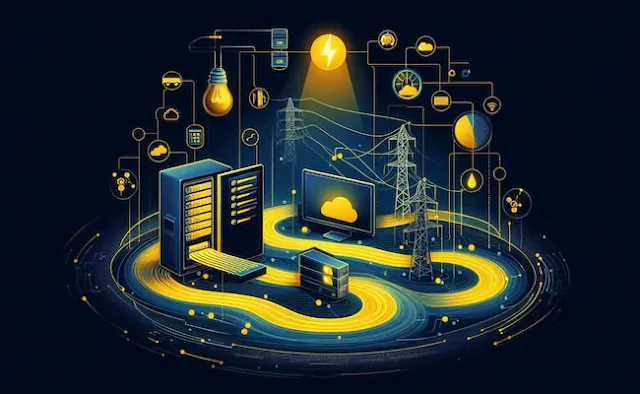AI's Massive Energy Hunger: Can Innovations Curb Its Climate Impacts?
 |
| AI technology is driving an upsurge in energy consumption globally (Disclaimer: AI Generated Image) |
Artificial intelligence promises immense benefits but its vast energy appetite threatens sustainability goals. Can efficiency gains and policies curb AI's carbon emissions?
Artificial intelligence relies on power-hungry data centers. As innovative AI capabilities demand more computing, how can we balance climate protection with technological progress?
The Hidden Cost of AI's Voracious Energy Appetite
Artificial intelligence (AI) promises to revolutionize everything from healthcare to transportation. However, AI has a dirty little secret - its vast appetite for energy threatens global climate goals. As AI capabilities rapidly advance, policymakers scramble to curb emissions from data centers powering the technology. Consumers also have a right to know the environmental impact of their GenAI searches.
Why Does AI Consume So Much Power?
You use AI every day without even realizing it. When you ask Siri to set a timer or chat with Alexa, those conversations happen in far-away data centers packed with servers running machine learning algorithms.
"Machine learning" teaches computer programs to make decisions by processing oceans of data. For example, self-driving cars use AI to interpret camera inputs and navigate roads.
Operating advanced AI requires specialized computer chips and massive amounts of electricity. In fact, training a single machine learning model can emit over 6 times the lifetime carbon emissions of the average American car!
The More Powerful the AI, the Hungrier It Gets
As AI capabilities grow more complex, their energy demands skyrocket. For instance:
- AI start-up Anthropic's new Claude model builds on OpenAI's famous GPT-3 language program. Claude required 3-4 times more computing power than GPT-3.
- Google's latest AI search upgrades will theoretically need 10 times more power per query.
Crunching endless data on such a massive scale necessitates rows of energy-guzzling servers and cooling systems.
![Server racks in data center][]
Server racks in Apple's data center (Source: Unsplash)
Measuring AI's Carbon Paw Print
Environmental scientists utilize life cycle assessments to calculate products' cradle-to-grave environmental impacts. Likewise, we can measure AI models' carbon footprints from creation through usage.
For example, training the popular GPT-3 model emitted over 500 tons of CO2 equivalent - 20 times more than an alternative model called BLOOM! Factors like hardware efficiency and coding choices influence carbon costs.
Also, while data center electricity consumption currently accounts for ~1% of global energy, adding widespread AI could balloon that share to 4.5% by 2030. Companies increasingly locate data centers in cold climates to reduce cooling demands - and some even build on polar ice sheets!
Your GenAI Searches Leave Digital Exhaust
Think about how often you Google something on your phone each day - now imagine if each of those searches consumed 10x more energy.
- Before: 0.0003 kilowatt-hours (KWh) per search
- After: 0.003 KWh per AI-enhanced search
That's enough electricity to power a standard 9-watt LED lightbulb for 20 minutes! And with over 8 billion Google searches daily, those tiny energy hits quickly add up.
By incorporating AI in search, Google's projected energy appetite would feed 29 billion megawatt hours per year - comparable to a small country's total consumption!
Policies Push for AI Sustainability
With AI's climate impacts projected to keep rising, policymakers are stepping up interventions through carrots and sticks.
For example, new EU regulations mandate data center operators disclose energy/water usage and efficiency measures. The US Artificial Intelligence Environment Impact Act also proposes convening experts to study AI's environmental consequences.![Wind turbines providing renewable energy][]
Companies increasingly rely on wind and solar for power (Source: Unsplash)
The tech sector recognizes climbing criticism over AI's ballooning energy appetite. For example, OpenAI CEO Sam Altman admits we need "breakthrough technologies like nuclear fusion" to sustainably meet future computational demands.
Additionally, tech giants like Google and Microsoft publicly report carbon footprints and invest in renewable power purchases and carbon removal offsets.
What's Next for Green AI?
While data transparency and clean energy help tame emissions, computing efficiency limits remain. Researchers are thus exploring innovative technologies to curb AI's climate impacts:
- Specialized AI computer chips reduce power needs
- Algorithms enhance model accuracy using less data
- Carbon-aware model training minimizes lifetime emissions
Furthermore, international cooperation can align AI innovation with climate goals through platforms like the UN's AI for Good initiative.
Conclusion: Towards Responsible AI Progress
AI holds tremendous promise to improve human lives, however unchecked energy consumption threatens sustainability. As consumers, we have a right to factor environmental impacts into our technology choices.
Through smart policies and responsible development, the AI community can proactively address external consequences. If AI is to fulfill its highest purpose, efficiency and ethics must accompany rapid technical improvements. Our shared future depends on harnessing AI to build an equitable and climate-resilient society.
Check out more articles explaining AI's environmental pros and cons. Please share your thoughts in the comments on pathways towards responsible AI innovation!




%20a%20line%20gra.webp)


0 Comments